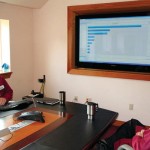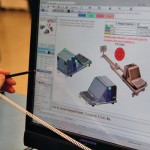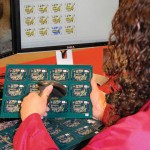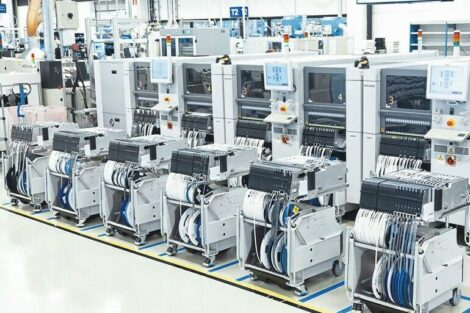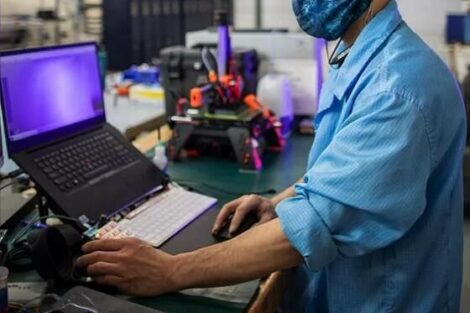Enercon, a Maine-based contract manufacturer, recognized that a single-source, realtime paperless documentation system would significantly improve their manufacturing execution. Accordingly they turned to Aegis Software, whose MOS product offered the industry-leading solution to the functionality they sought. This case study looks at their background and requirements, and how these were fulfilled by the software in terms of its features and its implementation across their enterprise.
Aegis Software, Horsham, PA (USA) & Enercon Technologies, Maine (USA)
Enercon Technologies is a privately held contract manufacturer serving Original Equipment Manufacturers (OEMs) and well funded high-tech start-ups. Founded in 1980, the company has grown and evolved over the last three decades. With state-of-the-art ISO and FDA registered facilities, the company’s capabilities range from product design and engineering through volume manufacturing to service depot support. The company works with its clients to streamline their development cycle, reducing time-to-market and total cost. The EMS operation includes SMT and through-hole circuit card assembly, cable assembly, and integration of these and other components into chassis and enclosures. About 70% of these assemblies start with design services, and production activities are distributed between two closely located manufacturing facilities in Maine. The company supplies 40% of their output to the medical industry, 30% into defense and 20% into commercial applications. Their mission is to provide world-class design, development, manufacturing, service and support solutions, 100% on-time and error free to Original Equipment Manufacturers at best value. In 2006, as part of their strategy for mission fulfillment, Enercon identified a need for an on-line MES system that could radically improve its manufacturing execution. The key component of this was to be a single, universally visible document source providing real-time manufacturing and quality information. Costs of accessing and acting on this information should be driven significantly below those of the existing legacy systems.
Requirements fulfilled
Aegis was selected because its Manufacturing Operations Software (MOS) demonstrated the industry’s best ability to meet the company’s single source manufacturing execution and traceability documentation requirement, more cost-effectively and with less overhead. The software was clearly the product most capable of delivering the information visibility, availability and speed of access identified by the contract manufacturer as essential to meet their process improvement goals. Especially with the inSite mobile device app, this unprecedented new level of information access was opened up across the entire enterprise, providing a ubiquitous information environment throughout and beyond its production areas.
The study focused on a medical device for conducting pediatric eye screening that was originally presented to the company as a large suitcase-sized prototype, which Enercon designed down into a smaller scale device that now can be held in two hands. This device provides a particularly informative example as it concerns a cradle-to-grave product, now processes through all their production areas. Aegis MOS provides rich traceability of each unit’s life throughout this entire manufacturing process, critically including the RMA and direct returns procedures, which serves as the Device History Record (DHR) for each unit.
Starting with their new product introduction (NPI) effort, the software establishes the single source of production information, and delivers to its staff at each location in every production line assured access to the detailed, correct and updated information for the product and version they are currently manufacturing. It also collects production and quality data from every area of the production process in real time, making it immediately visible to supervisors and managers irrespective of their location within or outside the manufacturing facilities. This data can be displayed and distributed within user-configured reports or in response to more detailed queries on demand. Crucially, this functionality was set up by Enercon’s production staff simply as a configuration exercise; no specialist software effort was needed or used. A closer look at the implementation shows exactly how the company used MOS to achieve the manufacturing execution improvements they sought.
The documentation process
The process engineers allocate a portion of their day to work instruction development which they perform entirely within Aegis’ iLaunch environment. Circuit board assembly instructions use easy to follow color-coded visual aids that utilize a CAD-intelligent image of the circuit board. This allows dynamic reference location searches, pan-and-zoom control with the ability to click on a component and see rich information about its part detail, and first article inspection to guide an operator through each location on the board. Cable assembly instructions also feature visual aids used to define wire lengths, shrink tubing, crimps, terminals and connectors, as well as information for assembly inspection and test.
Work instructions are also generated for enclosure level assembly and final integration. An operation at this level typically spans several pages, includes step-by-step instructions, and incorporates a generous array of digital images showing graphically how the work should be performed. Beyond the instructions developed in iLaunch, they also add documents and files created externally to Aegis ‘Reference Library’, from where they can be made visible to shop floor personnel using the Aegis MES browser. Documentation control for the company’s live manufacturing process is handled entirely by the software, whose completely paperless environment has considerable advantages over the paper-based system it replaced. Their former method relied on a folder or binder for each assembly’s revision documentation, in which information was redlined, crossed out, and modified. Under these circumstances, revision control was difficult, and ensuring that every operator was working on the same, correct documentation was time-consuming and unreliable. Additionally, binder storage, paper costs, and labor for every change all added to the total documentation workload and cost. These problems have all been eliminated, which is administered from a Documentation Control Center located at the heart of the production area. Its apearance is similar to a nurse’s station on a hospital floor and its role is just as critical.
One of the responsibilities in ‘Doc Control’ is to create jobs based on work orders that originate from SyteLine, the ERP system of the manufacturer. The work orders are reconciled with the BOM and work instruction appropriate to the target assembly and revision level. New revisions are created when necessary, based on an earlier revision’s documentation set updated with the changes to the affected operations.
If a job requires any exceptions, Job Exception Notifications (JENs) are raised and broadcast through Aegis. Unlike a revision, a JEN describes a temporary change to a process. Changes are presented as a PDF through the MES browser, which notifies operators when their current job is affected by a JEN. A third of all the jobs run on the production floor are affected in this way.
Unit ID registration is also managed by Doc Control, where barcode ID labels are affixed to the bare circuit boards. The MOS software has had a huge impact on quality as well. Before its deployment, defects were recorded on ‘tick sheets’ and then keyed into an Excel spreadsheet for later analysis. The analysis was an intensely labor intensive process, so its conclusions were typically reported a month after data entry. This delay made the results less meaningful, and less effective for use in corrective strategies. By contrast Aegis, since its installation four years ago has been capturing defect data as it is generated from all locations across the production area and making it visible instantly. AOI machines collect defect data automatically for transmission to MOS via the Aegis-supplied xLink web service adapters, while inspectors enter the data by touching an affected area, component or connector within a product image displayed on an Aegis touch screen terminal.
Enercon has been specific in identifying reporting improvements and defect level reductions achieved since the MOS installation. The Quality reports and reviews, which are now automated, are generated weekly by default instead of monthly, as well as immediately on demand. Defect Pareto distributions are also automated, with the top two weekly reported defects now being 90% less than four years ago. Defects per million opportunities (DPMO), entirely automated within MOS, has levels 80% below those of three years ago.
This transformation of data availability has been timely for the company as their clients increasingly expect them to possess, and respond rapidly to, information about their built products. The management has also come to rely on Aegis for quality and traceability information. Accordingly they enjoy better awareness of current production status and more informed decision-making for corrective actions and control. Aegis generates, schedules, and emails weekly defect reports every Sunday through the Data Miner application that provides ad hoc historical data analysis. This includes running pre-defined templates to return results in chart, pivot table and report form. It also allows investigation of quality issues through drill-down bar charts, referenced by product, customer, inspection point, inspector, defect code and other criteria. DPMO is also automatically calculated.
Enercon recently upgraded to the current software release to enjoy the benefits of inSite, Aegis’ manufacturing visibility mobile app for iPhone or iPad devices. This provides production awareness by showing numbers of units scanned, together with pass and failure rates. It also reveals work order and job progress. Additionally, inSite provides quality information in terms of yield, defect analysis and unit traceability. In product recall situations, inSite identifies units containing specific part number lots.
The DHR generated for each unit is a key repository for production history and traceability. Product route history includes records of operator performing assembly tasks together with the date and time, physical work location and WIP status. Genealogy is also recorded, relating serial numbers of ‘parent’ enclosures to those of their constituent ‘child’ boards and cables. Additionally, parametric values including MAC addresses, purchase part numbers, temperatures subjected to, torque values, and set points are stored. Each unit’s DHR also defines exactly how it should be built as it includes the unit’s revisions approval record and any JENs currently applicable during manufacturing. Defect/repair records are also maintained; a particularly important point as repaired units are shipped directly back to enduser custo-mers.
Installation review
The MOS system has been installed and running for over five years; enough time to demonstrably fulfill the expected benefits of improved manufacturing productivity and quality control through a single source paperless documentation environment. Additionally, its quality system has radically improved Enercon’s defect management by collecting information in real time from all areas and making it immediately available within analysis and reports, rather than after a month’s intensive effort as previously.
“Aegis has always been, and continues to be a very strong system partner,” commented Ryan Marcotte, Enercon General Manager. “We were impressed with how Aegis overcame the installation’s challenges, committing the resources to ensure delivery of the promised platform on time and within budget. Additionally, we have benefited from Aegis’ position as the industry leading manufacturing operations solution provider, as they continue to deliver new and innovative functionality such as the inSite app. This in turn allows us to offer ever-improving solutions and value to our customers”.
Zusammenfassung
Die Case Study zeigt auf, wie ein EMS Dienstleister durch die Implementierung einer MOS-Software die Qualität seiner Produkte nicht nur erhöhen konnte, sondern auch die gesteckten Ziele zur Verbesserung seiner Prozesse mühelos erreichte.
L’étude du cas démontre comment un prestataire de services EMS ne s’est pas contenté de pouvoir augmenter la qualité de ses produits par un logiciel MOS, mais aussi comment il a pu atteindre sans effort les objectifs affichés pour l’amélioration de ses processus.
Share:




